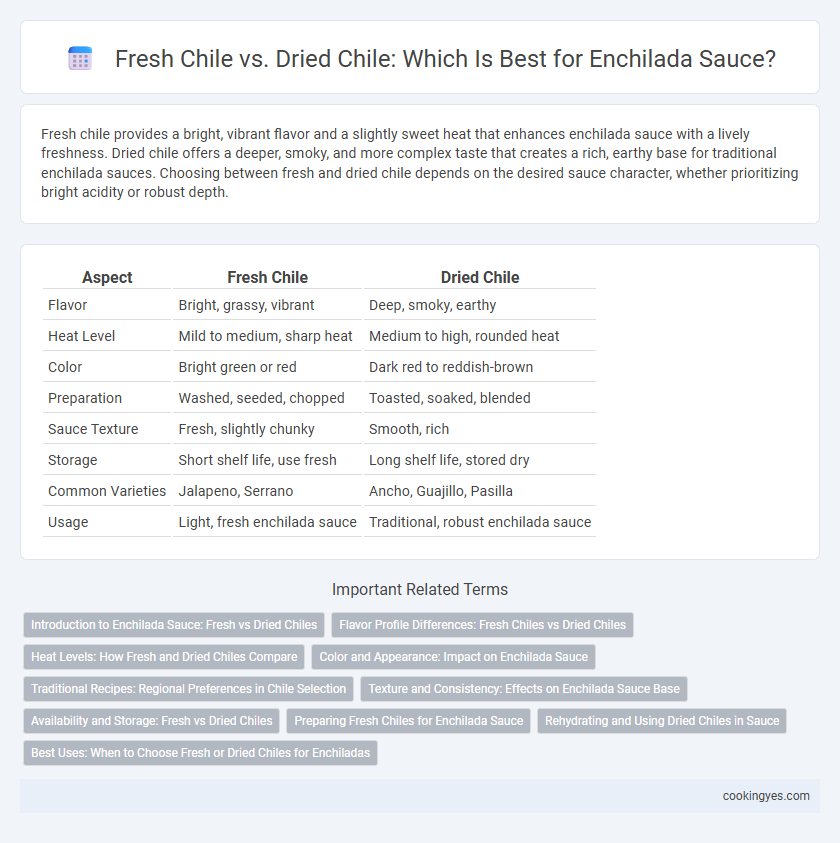Fresh chile provides a bright, vibrant flavor and a slightly sweet heat that enhances enchilada sauce with a lively freshness. Dried chile offers a deeper, smoky, and more complex taste that creates a rich, earthy base for traditional enchilada sauces. Choosing between fresh and dried chile depends on the desired sauce character, whether prioritizing bright acidity or robust depth.
Table of Comparison
| Aspect | Fresh Chile | Dried Chile |
|---|---|---|
| Flavor | Bright, grassy, vibrant | Deep, smoky, earthy |
| Heat Level | Mild to medium, sharp heat | Medium to high, rounded heat |
| Color | Bright green or red | Dark red to reddish-brown |
| Preparation | Washed, seeded, chopped | Toasted, soaked, blended |
| Sauce Texture | Fresh, slightly chunky | Smooth, rich |
| Storage | Short shelf life, use fresh | Long shelf life, stored dry |
| Common Varieties | Jalapeno, Serrano | Ancho, Guajillo, Pasilla |
| Usage | Light, fresh enchilada sauce | Traditional, robust enchilada sauce |
Introduction to Enchilada Sauce: Fresh vs Dried Chiles
Enchilada sauce base varies significantly between fresh and dried chiles, impacting flavor, heat, and texture. Fresh chiles offer bright, vibrant, and slightly tangy notes, while dried chiles provide deep, smoky, and rich complexity essential to traditional enchilada sauces. Choosing between fresh and dried chiles shapes the sauce's aroma and intensity, influencing the overall enchilada experience.
Flavor Profile Differences: Fresh Chiles vs Dried Chiles
Fresh chiles provide a bright, grassy, and slightly fruity flavor that adds vibrant heat to enchilada sauce, while dried chiles contribute deeper, smoky, and earthy notes with a richer complexity. Varieties like fresh jalapenos or serranos offer crisp, sharp heat, whereas dried ancho, pasilla, or guajillo chiles introduce mild to moderate sweetness alongside smoky undertones. Combining fresh and dried chiles can balance brightness and depth, creating a layered, nuanced enchilada sauce profile.
Heat Levels: How Fresh and Dried Chiles Compare
Fresh chiles generally offer a brighter, more vibrant heat that can feel sharper and more immediate in enchilada sauce, while dried chiles provide a deeper, more complex heat with smoky undertones. The capsaicin concentration in dried chiles often intensifies during the drying process, resulting in a more potent and lingering spiciness compared to the fresh counterpart. Choosing between fresh and dried chiles for enchilada sauce impacts the overall heat profile, with fresh chiles delivering a crisp, upfront heat and dried chiles contributing a richer, more robust warmth.
Color and Appearance: Impact on Enchilada Sauce
Fresh chile imparts a vibrant, bright red or green color to enchilada sauce, enhancing the sauce's visual appeal with a lively, appetizing hue. Dried chile, by contrast, produces a deeper, richer, and often darker red or reddish-brown color that gives the sauce a more rustic, intense appearance. The choice between fresh and dried chile significantly influences the enchilada sauce's presentation, affecting its overall attractiveness on the plate.
Traditional Recipes: Regional Preferences in Chile Selection
Traditional Mexican enchilada sauce varies regionally, with fresh chiles like poblano and jalapeno favored in northern Mexico for their bright, fruity flavors and moderate heat. In contrast, southern regions often prefer dried chiles such as ancho, guajillo, and pasilla, which contribute deep, smoky, and earthy undertones essential to classic enchilada sauces. These regional chile selections influence the complexity and authenticity of the enchilada's flavor profile, reflecting local agricultural practices and culinary heritage.
Texture and Consistency: Effects on Enchilada Sauce Base
Fresh chiles produce a vibrant enchilada sauce with a lighter, smoother texture and a more fluid consistency, allowing the sauce to coat tortillas evenly without overwhelming heaviness. Dried chiles contribute a richer, thicker sauce with a slightly grainy texture due to rehydration and blending, which creates a more concentrated flavor that clings well to enchiladas. The choice between fresh and dried chiles directly affects the sauce's mouthfeel and thickness, influencing the overall eating experience.
Availability and Storage: Fresh vs Dried Chiles
Fresh chiles offer vibrant flavor and moisture but have limited availability and a short shelf life, requiring refrigeration and quick use. Dried chiles provide concentrated taste with extended storage capability, often kept in airtight containers at room temperature for months. Choosing between fresh and dried chiles depends on ingredient accessibility and how long the enchilada sauce base needs to be preserved.
Preparing Fresh Chiles for Enchilada Sauce
Preparing fresh chiles for enchilada sauce involves washing, seeding, and deseeding to control heat and bitterness. Roasting the chiles enhances their smoky flavor and softens the skin, making them easier to blend into a smooth sauce. Using fresh chiles provides a vibrant, bright flavor compared to dried chiles, which offer deeper, more concentrated heat and earthy tones.
Rehydrating and Using Dried Chiles in Sauce
Dried chiles such as ancho, guajillo, and pasilla require careful rehydration in hot water for 15-30 minutes to unlock their deep, smoky flavors ideal for enchilada sauce. After rehydration, blending the softened chiles with garlic, onions, and spices creates a rich, complex base that fresh chiles often lack due to their brighter, sharper taste. This drying and rehydration process intensifies the chile's flavor and adds a smooth texture crucial for authentic enchilada sauces.
Best Uses: When to Choose Fresh or Dried Chiles for Enchiladas
Fresh chiles offer bright, vibrant flavors and a mild to moderate heat, making them ideal for lighter enchilada sauces or dishes needing a fresh, zesty profile. Dried chiles, such as ancho, guajillo, or pasilla, provide deep, smoky, and complex flavor layers perfect for rich, traditional enchilada sauces with robust, earthy tones. Choosing fresh or dried chiles depends on the desired sauce intensity and texture, with dried chiles better for slow-cooked sauces and fresh chiles suited for quicker, fresher preparations.
Fresh chile vs dried chile for enchilada sauce base Infographic

 cookingyes.com
cookingyes.com